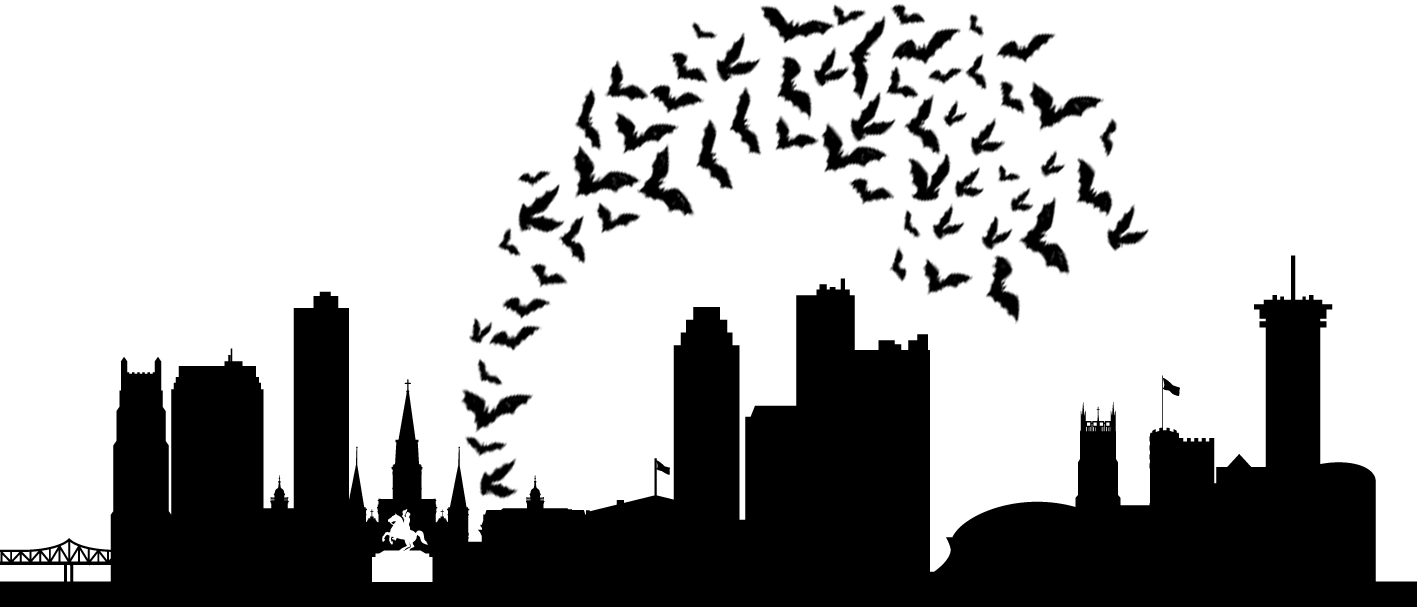Disturbance in Your Mind
Interview with a Vampire Scholar
Alison Fensterstock explores esoteric Louisiana with an investigation of New Orleans vampires.
Published: December 7, 2017
Last Updated: December 7, 2018

The topic? Basically, vampires.
The point of contention was, specifically, the vampire Lestat, the star of Ms. Rice’s Vampire Chronicles series, first brought to (undead) life on the page about twenty years prior and, more recently, portrayed on the big screen by Tom Cruise. On the final page of Memnoch the Devil, the latest installment at the time, Rice had had her vampire, residing in present-day New Orleans, indulge in a bit of existential reckoning as he gazed into the window of a former Mercedes dealership on St. Charles Avenue. The neglected building was a perfect backdrop for the fictional creature’s angst. The problem was, though, that the abandoned storefront was real—and it wouldn’t stay empty for long.
Copeland, the founder of Popeyes Fried Chicken, had bought the place and renovated it from picturesque blight into a flashy, neon-lit restaurant called Straya. Rice wasn’t the only one who thought it was hideous, probably, but she was the one with the cash and the sense of drama to take out an ad declaring so. The pair volleyed ads back and forth; Rice even wrote some in the voice of her character. Copeland sued for libel. (“Copeland Fries Rice,” the Times-Picayune announced.) Carnival parades, of course, fed hungrily on their antics for float-inspiring satire.
It was one of the best public feuds in New Orleans since Lestat first moved here, which was in the middle of the eighteenth century. And, arguably, there was more at stake (pun intended) than just a personal style disagreement. The allure of the vampire had, by the mid-nineties, become its own tourism driver of sorts. Lestat, Bragg wrote, was “perhaps the most famous bloodsucker of all time after Bram Stoker’s classic Dracula,” and Rice, a talented setter of vivid scenery, had moved him to her hometown for understandable reasons.
John Edgar Browning, a visiting lecturer at the Georgia Institute of Technology School of Literature, Media, and Communication, is as close as one might come to a twenty-first century vampire expert, although he does not bill himself explicitly as such. His doctorate is in American Studies and his master and undergraduate degrees are in English, but the undead—the pop-culture depictions and older mythology of such, plus other aspects we’ll get to later—are the through-line of his work, and he has edited, written, and co-written a long list of books and articles on that chilly subject.
New Orleans and South Louisiana (where he spent a significant amount of time while doing doctoral work at Louisiana State University) don’t actually have a ton of early native vampire lore, he said. The first American vampire tales—both new fiction and reports of actual vampire activity—instead tended to cluster in the New England colonies.
“Initially, I think a lot of the early American colonizers brought European vampire beliefs and superstitions with them,” he said. “And we really start to see the use of the vampire mythology cropping up in America pretty early on.” There were newspaper reports of graves being exhumed out of the suspicion that the deceased was a vampire, particularly when his or her family or other intimates seemed to suffer the wasting effects of tuberculosis, then often called consumption, he said. If the exhumed body seemed suspiciously robust, he said, “they would assume that their inkling was correct, and they would perform various practices to kill that vampire, or kill that person a second time.” Such cases, he said, were documented from the earliest colonial days up until the 1890s, but not in Louisiana.
Gloomy, romantic New Orleans seems like exactly the sort of spot where they’d want to live (or, technically, not live).
“New Orleans doesn’t have a whole lot of vampire lore dating back centuries in the same way New England does,” he said. “I think you probably had people hearing about some of the vampire cases happening up north, but there wasn’t a particular vampire lore or mythology in New Orleans, one, two, or even three hundred years ago.”
The vampire may not have been authentically native to New Orleans, Browning said, but it’s important that it seems as if it is, or ought to be. “When we think about the vampire of folklore, that vampire was not attractive. It was a dead villager who was probably bloated, wearing a death shroud, and it just was a very disgusting thing. In fact, it would be very similar to what we look at as zombies today,” he said—very different from the caped, sophisticated aristocrats, often portrayed as somewhat sympathetic—even kind of sexy—in their immortal torment. That kind of vampire started turning up in European literature in the early nineteenth century, reaching an apex with Bram Stoker’s Dracula in 1897. Gloomy, romantic New Orleans seems like exactly the sort of spot where they’d want to live (or, technically, not live).
“People associate New Orleans and Louisiana with the gothic,” he said. “I mean, it just sounds like a place where these kinds of things would happen. In fact, early American gothic lit often takes place in the South, in particular in Louisiana and New Orleans. And the same thing happens in film. If you’re going to have a vampire film, you’re going to have to have it somewhere where people would identify with vampires, a place they think vampires would occupy. Which is why True Blood did so well. So when you have this sort of gothic mystique around New Orleans, I think it lends itself for the folkloric vampire sort of creation stories to happen.”
And indeed they did. Post-Rice (“How much do you think Anne Rice has to do with this?” I asked Browning. “Definitely a lot,” he said.) there was New Orleans resident Poppy Z. Brite’s 1992 cult goth-punk novel Lost Souls, set in the present day, as well as Andrew Fox’s comic Fat White Vampire Blues from 2002. Contemporary New Orleans vampires also turned up in a 1998 story arc of DC Comic’s Preacher. The chorus of Concrete Blonde’s song “Bloodletting (The Vampire Song),” from 1990, references New Orleans. Today there are multiple vampire tours set in the French Quarter and Garden District, a vampire boutique on St. Ann Street (the owner of which also organizes vampire-themed tourist experiences and recently published a history of the city’s most popular vampire myths), a long-running annual Halloween-time vampire ball dedicated to Rice’s fictional world, and even a thriving local community of actual self-identified vampires—topics we’ll explore in the next installment of this column.
As for Anne Rice and Al Copeland: according to Bragg’s New York Times report, a Times-Picayune poll at the time saw New Orleanians taking Copeland’s side, 3 to 1. Both combatants are no longer with us—Copeland died in 2008, and Rice, though she is a New Orleans native, moved back to California, where she had lived on and off for years.
The garish pink spot on St. Charles Avenue, though, still bears Copeland’s name, which might lead one to conclude that the Fried Chicken King won that fight. But if we believe in them, the other team has all the time in the world.
—
Alison Fensterstock writes about American culture for outlets including NPR, Pitchfork, Rolling Stone, and others. She has served as the music critic for both Gambit and The Times-Picayune in New Orleans and was the founding program director for the Ponderosa Stomp Foundation.
